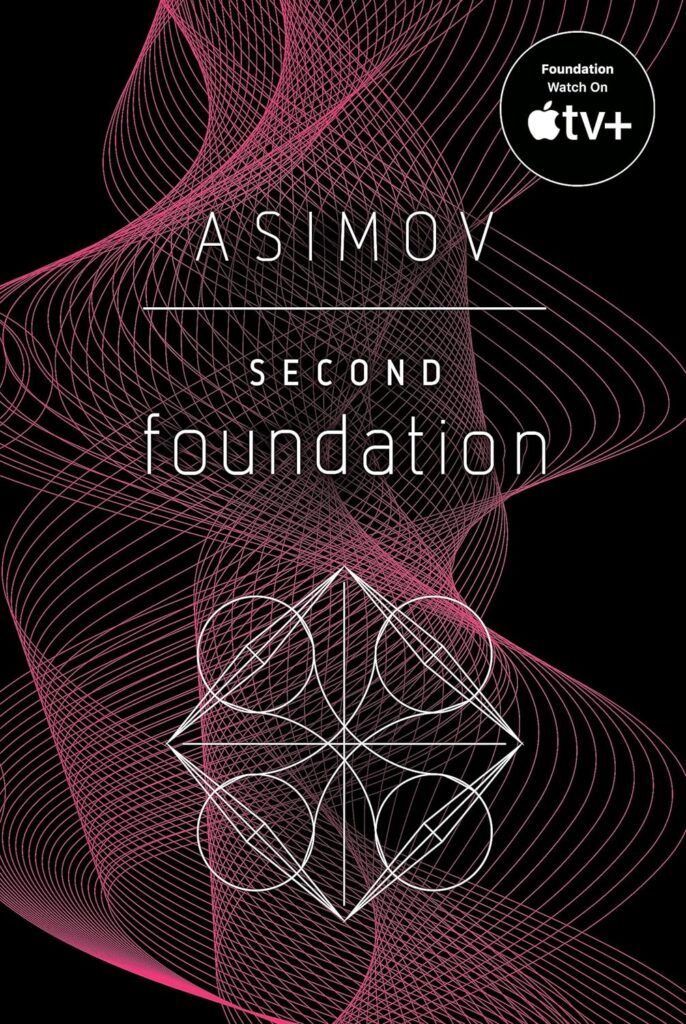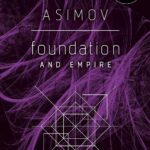
To finish up my re-reading of Isaac Asimov’s original Foundation trilogy, this week I’m looking at his Second Foundation. The novel, published in this form in 1953, is a reprinting of two novellas published in Astounding magazine in 1948-50. This third novel may not have quite the dramatic impact of The Mule (in Foundation and Empire) but that is because its climactic moments are all about confrontations of minds rather than spaceships or tension that can be resolved by blasters. For me, Second Foundation and the trilogy as a whole comprise one of the most successful examples of novels in which the protagonist is not a person or a place but an idea.
That idea, of course, is psychohistory and Hari Seldon’s plan to shorten the period of barbarism following the fall of the Galactic Empire. The drama of this book revolves around two searches for the home planet of the Seldon plan’s protectors. One search, by the Mule, aims to destroy the Second Foundation. The other, undertaken by a group within the original Foundation, aims to prevent its leaders from supplanting them in controlling a new empire.
Interspersed among the chapters describing these searches are “interludes” among leaders of the Second Foundation. These short sections offer the first extended view we’ve had about this mysterious organization. The members of this group are known only by the order in which they are allowed to speak, and most of the interludes in this novel take place between First Speaker and a student who will have to go through exhaustive training and testing before being admitted to this exclusive group.
These Speakers are the elite among the small group of psychologist/mathematicians who are the primary caretakers of Seldon’s plan. The equations capturing the plan are contained in a small black object called the Prime Directive which can project parts of the plan under review onto the walls of a meeting room. Very rarely, and only after exhaustive vetting, minor changes can be made to the equations to keep the plan on track. The Second Foundation leaders believe that absolute secrecy about their identity and location is essential to keep intruders from interrupting progress toward a new empire within the thousand year period originally predicted by Seldon. But who ensures that these changes are translated into action?
The driver of the story, and both searches, is not just the attempt to find the location of this hidden organization but also the rooting out of Second Foundation operatives. These people have taken positions around the galaxy wherever Second Foundation believes changes need to be made to keep the plan on track. (Compare the plot of Asimov’s The End of Eternity where something similar forms the background of the story.) Like the Speakers, these agents have powerful capabilities to alter the thoughts of people they come in contact with, and without the subjects of manipulation becoming aware of this hidden influence. Unlike the Mule, who has the power to alter emotions of whole populations to instill absolute loyalty, the Second Foundation agents can alter thoughts of individuals and need to be in contact with those whose minds they want to influence.
Part 1 is the search by the Mule, whose identity was revealed at the end of Foundation and Empire by Bayta Darell, one of Asimov’s better attempts at a woman character. I was hoping to see more of Bayta in this story, but no such luck. The story opens five years after the end of Foundation and Empire with two people summoned to appear before the Mule (now known as First Citizen of the Union) at his palace on Kalgan. The Mule wants to create Seldon’s new empire in 300 years instead of 1000, but he has found some people around him subtly tampered with, he assumes, by agents of the Second Foundation. It has become urgent for him to locate the hidden organization and take it over or destroy it because it is the only obstacle in his path.
So he sends Han Pritchard and Bail Channis on this search mission. After Channis’ efforts to identify the Tazenda system as the right location, the Mule appears with his fleet to find the truth. He forces Channis to admit he is a Second Foundation agent, but then the First Speaker appears and has his own confrontation with the Mule. In their intense but silent battle of minds, the First Speaker so alters the Mule’s thinking that he gives up the search, as well as his imperial dreams.
Part 2 jumps ahead 60 years. The Mule is long dead, but the Foundation has an inner circle of people, who meet at the home of Dr. Toran Darell (Bayta’s son) convinced they must find Second Foundation for a very different reason. They discover, thanks to encephalographic readings, that many people on Terminus have come under the mental control or tampering by Second Foundation agents. Dr. Darell’s daughter, Arcadia, is a brilliant 14 year-old who has a Holmesian keenness of observation and deductive powers. She has been secretly listening in to the plans of the group. Dr. Darell, and the other members of the group decide to send one of their number, Homir Munn, to Kalgan to find evidence of the Second Foundation location. Arcadia hears this and arranges to become a stowaway aboard his small spaceship.
They arrive at Kalgan but are at first rebuffed by Stettin, the current warlord of the planet, until Arcadia manages to persuade him to let Munn do his research in the records. But Stettin becomes suspicious that his court might have been infiltrated by the Second Foundation and arrests Munn. Arcadia escapes with the aid of Stettin’s mistress. At the spaceport, she runs into a farmer/trader named Preem Palver who takes the girl with him and his wife to their home on Trantor.
Meanwhile, Stettin is preparing a full-scale invasion of the original Foundation on Terminus. In the closest we come in this series to a real space battle, Stettin’s huge fleet is outflanked by Foundation forces, partly due to Second Foundation influence dampening the morale of Kalgan’s forces while bolstering that of Foundation. Dr. Darell has in the meantime invented a machine that generates a kind of static that cancels out Second Foundation mental influence and can be fatal to its agents.
There are a lot of back and forth accusations within the group about who is or isn’t an agent and where the Second Foundation might be. But even when the agents are unmasked, it turns out that their conditioning is such that they really believe in the false locations that have been implanted in them. Arcadia has sent a clue to her father that leads him to believe that Terminus is the “real” center of Second Foundation, but in the end we find that this is also an implanted idea. The novel ends with a revelation of the true location and the identity of the First Speaker.
I couldn’t quite understand the animosity of the original Foundation for the Second one. After all, Hari Seldon created both as essential parts of his plan, and it was never clear to me why Dr. Darell and his group regarded it as such an enemy. The specter of mental manipulation and the presence of “enemy” agents in their midst posing as allies is disturbing, to be sure. (Surely, this idea was influenced by the Red Scare events of the period when Asimov was writing these stories.) But much of their concern seems also to be about Second Foundation becoming more important than the original one and assuming a dominant role in forming a new empire. The Foundation on Terminus has shown itself before to be susceptible to internal problems and periodic political upheavals, so I guess their animosity is another strange twist in that organization’s long history. In the end, it is important for the survival of the plan that its protectors within the Second Foundation remain secret.
The survival of the plan, after all, is everything in this series, far more important than individual characters, and that’s where Asimov keeps the focus of the storyline throughout the trilogy. He also creates some interesting characters, but they have a way of disappearing into the larger story arc of protecting the plan. In this novel, the Mule, at least early on, comes across as a figure of some complexity, burdened by loneliness and self-doubt, as well as possessing deep insight into the people around him. But all that falls away as he pursues his plans of conquest and meets his match in the First Speaker. Similarly, Arcadia Darell is introduced with a lot of subtlety as a strong character, but she loses that depth and agency as the story unfolds. Like many others, she only has a moment in the story as she serves the needs of the plan, and then she’s gone.
I found a lot to like in this trilogy, even though I didn’t expect to. The overall story remains strong, despite the dependence on so many conversational scenes. I found Asimov increasingly able to integrate strong action into those scenes, even while leaving many of the climactic confrontations off-screen. That made sense when I realized his focus was on the idea of the Seldon plan and the broad sweep of history rather than on individual character arcs.
I didn’t like putting up with the assumption of white male dominance, but it was to be many years before most American male writers woke up to the larger world they were leaving out of their stories. It took the publishers even longer to diversify the writers they were willing to work with, and many of them are still resistant. That’s not a justification since voices of minority and women’s rights had been sounding loud and clear for many decades before this. It’s just a fact that severely limited the worldview of much genre and “mainstream” American fiction for far too long, and still does.
Asimov left a lot of unanswered questions about both Foundations and the fate of the plan at the end of this trilogy, and it was to be more than 25 years before he returned to this universe with prequels and sequels. For now, I’m going to leave those four novels for another project. For me, the original trilogy remains a flawed but powerful achievement of the so-called Golden Age of Science Fiction.





I really enjoyed this series when I read it ages ago – I wonder what my thoughts would be if I did a reread too. Great post!
Thanks for stopping by – I found that the series gets off to a strong start with the opening chapter of Foundation (which Asimov wrote for novel publication in the 1950s) but stumbles in the first story that he wrote in 1941. It’s a mixed bag after that, but overall it remains a strong, unforgettable story – again making allowances for publishing and writing conventions of the 1940s that would never be allowed today.